Zanzibar City
Zanzibar City or Mjini District, often simply referred to as Zanzibar (Wilaya ya Zanzibar Mjini or Jiji la Zanzibar in Swahili) is one of two administrative districts of Mjini Magharibi Region in Tanzania.[1] The district covers an area of 15.4 km2 (5.9 sq mi).[2] The district is comparable in size to the land area of Nauru.[3] The district has a water border to the west by the Indian Ocean. The district is bordered to the east by Magharibi District. The district seat is located in Stonetown. The city is largest city on the island of Zanzibar. It is located on the west coast of Unguja, the main island of the Zanzibar Archipelago, north of the much larger city of Dar es Salaam across the Zanzibar Channel. The city also serves as the capital of the Zanzibar Urban/West Region. In 2012 its population was 223,033.[4]
Zanzibar City
Jiji la Zanzibar (Swahili) | |
|---|---|
 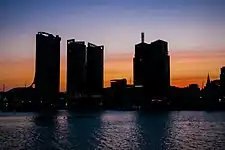 From top to bottom: Aerial view of Zanzibar City & skyline of Zanzibar City | |
| Nickname: Home of Stonetown | |
 Location in Unguja South | |
| Coordinates: 6.165°S 39.199°E | |
| Country | |
| Region | Mjini Magharibi Region |
| Capital | Stonetown |
| Government | |
| • Type | Municipal |
| • Mayor | Khatib Abdulrahman Khatib |
| Area | |
| • Total | 15.4 km2 (5.9 sq mi) |
| • Rank | 2nd in Mjini Magharibi |
| Population (2012) | |
| • Total | 223,033 |
| • Rank | 2nd in Mjini Maharibi |
| • Density | 14,000/km2 (38,000/sq mi) |
| Demonym | Wamjini |
| Ethnic groups | |
| • Settler | Swahili & Arabs |
| • Native | Hadimu |
Zanzibar City comprises two main parts, Stone Town and Ng'ambo (literally: "The Other Side"); the two areas are historically divided by a creek, now marked by a large street called Creek Road.[5][6] Stone Town is the historical core of the city, former capital of the Zanzibar Sultanate; because of its unique architecture and culture, it was declared a UNESCO World Heritage Site in 2000.[7][8] Ng'ambo is a much larger, modern area that developed around Stone Town after the Zanzibar Revolution, with office buildings and large apartment blocks such as those of the Michenzani neighbourhood.[5] Zanzibar City is served by a number of international and domestic airlines via Abeid Amani Karume International Airport.
History
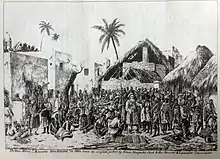
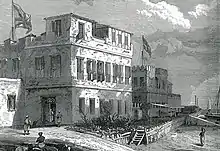

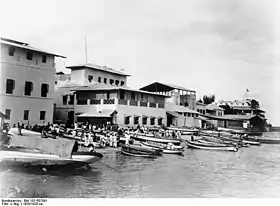

In 1592, the first English ship arrived in port. In 1824, Said bin Sultan, Sultan of Muscat and Oman established the capital of his kingdom in the city.[9] The city was a high place of slavery, one of the main ports of East Africa for the slave trade. The famous slave trader Tippu Tip lived there. In 1846, the island had 360,000 enslaved for 450,000 inhabitants. In 1866, the British explorer David Livingstone (1813–1873) stayed in Zanzibar to prepare his last expedition to Tanzania. In 1892, Zanzibar was declared a free port.
Climate
Zanzibar City has a tropical climate, very similar to whole Unguja island, and slightly hotter than what is found in Pemba. This climate is classified as a tropical monsoon climate (Köppen climate classification Am). The average temperature in Zanzibar City is 26.9 °C (80.4 °F). The average annual rainfall is 1,512 mm (59.5 in). The monthly average temperatures are usually between 25.1 and 28.8 °C (77.2 and 83.8 °F). There are two rain seasons, with most rainfall coming between March and May and smaller rain season coming between November and December. Drier months are January - February, and a longer drier season between June and October.
| Climate data for Zanzibar City (1991–2020) | |||||||||||||
|---|---|---|---|---|---|---|---|---|---|---|---|---|---|
| Month | Jan | Feb | Mar | Apr | May | Jun | Jul | Aug | Sep | Oct | Nov | Dec | Year |
| Average high °C (°F) | 32.6 (90.7) |
33.2 (91.8) |
32.5 (90.5) |
30.6 (87.1) |
29.7 (85.5) |
29.3 (84.7) |
29.0 (84.2) |
29.4 (84.9) |
30.4 (86.7) |
31.2 (88.2) |
31.0 (87.8) |
31.8 (89.2) |
30.9 (87.6) |
| Average low °C (°F) | 24.5 (76.1) |
24.3 (75.7) |
24.5 (76.1) |
24.5 (76.1) |
23.8 (74.8) |
22.9 (73.2) |
22.1 (71.8) |
21.1 (70.0) |
21.0 (69.8) |
22.0 (71.6) |
23.1 (73.6) |
24.0 (75.2) |
23.1 (73.6) |
| Average rainfall mm (inches) | 73.6 (2.90) |
50.8 (2.00) |
176.9 (6.96) |
408.5 (16.08) |
297.8 (11.72) |
51.9 (2.04) |
30.8 (1.21) |
37.7 (1.48) |
36.8 (1.45) |
115.7 (4.56) |
201.3 (7.93) |
167.7 (6.60) |
1,649.5 (64.94) |
| Average rainy days (≥ 1.0 mm) | 5.6 | 3.6 | 11.0 | 17.5 | 13.8 | 5.3 | 4.3 | 6.0 | 5.1 | 6.9 | 13.7 | 12.2 | 105.0 |
| Source: NOAA[10] | |||||||||||||
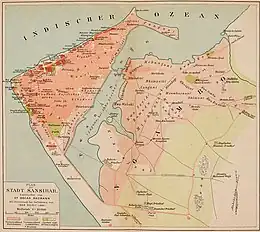
Places of worship
The places of worship in the city are predominantly Muslim mosques.[11] There are also Christian churches and temples: Roman Catholic Diocese of Zanzibar (Catholic Church), Anglican Church of Tanzania (Anglican Communion), Evangelical Lutheran Church in Tanzania (Lutheran World Federation), Baptist Convention of Tanzania (Baptist World Alliance), Assemblies of God.
Constituencies

For parliamentary elections, Tanzania is divided into constituencies. As of the 2010 elections the area for Zanzibar City District had ten of the nineteen constituencies in the region:[12]
- Amani Constituency
- Chumbuni Constituency
- Jangombe Constituency
- Kikwajuni Constituency
- Kwahani Constituency
- Kwamtipura Constituency
- Magomeni Constituency
- Mji Mkongwe Constituency
- Mpendae Constituency
- Rahaleo Constituency
Wards

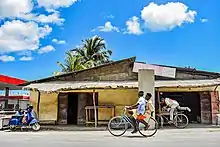
The Zanzibar Urban District is administratively divided into 45 wards:[13]
| Nr. | Ward (Shehia) | Population 2012[13] | Parliamentary Constituency |
|---|---|---|---|
| 1 | Shangani | 3,886 | Mji Kongwe |
| 2 | Mkunazini | 3,308 | Mji Kongwe |
| 3 | Kiponda | 1,654 | Mji Kongwe |
| 4 | Malindi | 3,204 | Mji Kongwe |
| 5 | Mchangani | 2,211 | Mji Kongwe |
| 6 | Vikokotoni | 1,872 | Mji Kongwe |
| 7 | Mwembetanga | 2,610 | Mji Kongwe |
| 8 | Kisiwandui | 1,590 | Kikwajuni |
| 9 | Kikwajuni Juu | 2,408 | Kikwajuni |
| 10 | Kikwajuni Bondeni | 2,257 | Kikwajuni |
| 11 | Kisima Majongoo | 2,615 | Kikwajuni |
| 12 | Miembeni | 6,095 | Kikwajuni |
| 13 | Kilimani | 2,911 | Kikwajuni |
| 14 | Migombani | 7,164 | Mpendae |
| 15 | Mpendae | 13,252 | Mpendae |
| 16 | Meya | 5,777 | Mpendae |
| 17 | Jang'ombe | 6,122 | Jang'ombe |
| 18 | Urusi | 7,532 | Jang'ombe |
| 19 | Matarumbeta | 2,711 | Jang'ombe |
| 20 | Kwaalinato | 5,438 | Jang'ombe |
| 21 | Mwembeshauri | 1,933 | Rahaleo |
| 22 | Rahaleo | 1,950 | Rahaleo |
| 23 | Mlandege | 2,070 | Rahaleo |
| 24 | Muembe Ladu | 2,954 | Rahaleo |
| 25 | Gulioni | 2,488 | Rahaleo |
| 26 | Makadara | 5,048 | Rahaleo |
| 27 | Kwaalamsha | 3,479 | Kwahani |
| 28 | Mikunguni | 2,984 | Kwahani |
| 29 | Kwahani | 4,815 | Kwahani |
| 30 | Kidongo Chekundu | 2,290 | Kwahani |
| 31 | Muungano | 5,304 | Kwahani |
| 32 | Sogea | 4,801 | Magomeni |
| 33 | Magomeni | 6,165 | Magomeni |
| 34 | Nyerere | 9,657 | Magomeni |
| 35 | Kwa Wazee | 6,454 | Magomeni |
| 36 | Sebleni | 5,102 | Amaani |
| 37 | Amaani | 6,156 | Amaani |
| 38 | Kilimahewa Bondeni | 5,116 | Amaani |
| 39 | Kilimahewa Juu | 4,714 | Amaani |
| 40 | Kwamtipura | 11,572 | Kwamtipura |
| 41 | Mkele | 7,140 | Kwamtipura |
| 42 | Shaurimoyo | 8,335 | Kwamtipura |
| 43 | Chumbuni | 10,925 | Chumbuni |
| 44 | Karakana | 8,610 | Chumbuni |
| 45 | Muembe Makumbi | 8,354 | Chumbuni |
| Total | Zanzibar Urban | 223,033 |
As of 2012, Mjini District was administratively divided into 20 wards.[14]
Wards
|
|
Demographics



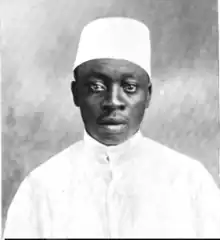
|
|
See also
References
- "Mjini District".
- "Kusini District Profile" (PDF). Government of Zanzibar. 2019. Retrieved 23 July 2022.
- 21 km2 (8.1 sq mi) for Nauru at "Area size comparison". Nation master. 2022. Retrieved 23 July 2022.
- "Tanzania: Regions, Districts, Wards, Cities and Urban Localities – Population Statistics in Maps and Charts". citypopulation.de. Archived from the original on August 9, 2012. Retrieved May 20, 2008.
- "An introduction to Zanzibar Town on the island of Zanzibar in Tanzania". zanzibar-travel-guide.com. Archived from the original on July 18, 2011. Retrieved November 25, 2010.
- Kevin Shilligton, Encyclopaedia of African History vol. 3, p. 1710
- "THE "STONE TOWN" OF ZANZIBAR". zanzibar-web.com. Archived from the original on July 24, 2008. Retrieved June 18, 2008.
- "Stone Town of Zanzibar". UNESCO. UNESCO. Retrieved 24 February 2022.
- Britannica, Zanzibar Archived July 14, 2020, at the Wayback Machine, Encyclopædia Britannica, USA. Retrieved January 5, 2020
- "Zanzibar Climate Normals 1991–2020". World Meteorological Organization Climatological Standard Normals (1991–2020). National Oceanic and Atmospheric Administration. Archived from the original on 17 September 2023. Retrieved 17 September 2023.
- Britannica, Tanzania Archived January 18, 2020, at the Wayback Machine, Encyclopædia Britannica, USA. Retrieved January 5, 2020
- "Organisations located in Zanzibar City - Tanzania". African Development Information. Archived from the original on 2012-09-04.
- National Bureau of Statistics Tanzania (web).
- "Mjini District".
Bibliography
External links
- . Encyclopædia Britannica (11th ed.). 1911.